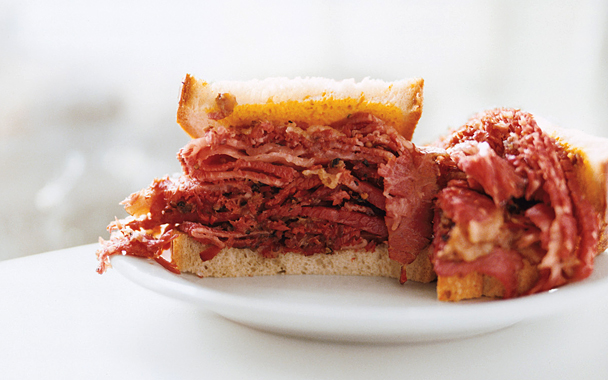My wife, Gretchen, and I recently found ourselves faced with a unique opportunity: to eat the famed smoked meat of Montreal, then travel back to New York and taste our home city’s notorious counterpart, pastrami, all within a few hours of each other. This rare, real-time comparison turned into a pastrami vs. smoked meat smackdown, as we tried to answer the fundamental question: “Which is better?”
Located on Montreal’s St. Laurent Boulevard—an area of small ethnic eateries and run-down architecture—Schwartz’s styles itself as a “Charcuterie Hebraique,” or Jewish deli. Founded in 1928 by Reuben Schwartz, a Romanian-Jewish immigrant, the deli has long been considered Montreal’s foremost purveyor of “smoked meat,” which everyone agrees is similar in several ways to New York’s pastrami, made from a whole brisket that’s been rubbed with spices and smoked. But there the similarities end.
According to Barry Lazar’s Taste of Montreal, Schwartz’s describes its brisket as brined, ostensibly in the manner of corned beef, but what this boils down to is a brining by osmosis: After being rubbed with spices and salt, the meat exudes liquid, in effect creating its own brine. After that process, Schwartz’s brisket is rubbed with crushed peppercorns and other spices and smoked for ten to 14 days, by the deli’s own account—though, as an aficionado of Texas-style barbecued brisket, I’d have to say that seems like an exaggeration.
As a lure to passersby, a heap of smoked briskets is piled in Schwartz’s window. The exterior of the briskets looks quite different from pastrami—yellower and more oily—and I can well believe they’ve been brined and smoked longer than Katz’s. According to some reports, the spice mixture contains coriander seed, black pepper, garlic, and sugar. The exact recipe remains a closely guarded secret.
The interior of Schwartz’s is small and cramped, perhaps a dozen tables with metal dinette chairs, and additional seating along a counter that allows you to watch the smoked-meat wranglers at work. Written in French and English, the menu is spare. The French fries were excellent, and the deli charges extra for its sour pickles, which it comically calls “cornichons.”
Schwartz’s smoked-meat sandwich is small by New York standards, but it’s also cheap—a little more than $4, a real bargain. To our delight, the waiter asked, “Do you want your smoked meat lean, medium, or fatty?” No contest. “Fatty, of course,” we happily replied. The meat was garnet in color, had a grainy and slippery texture, and was bursting with a smoky, peppery flavor. The spice rub seemed a little light, but I deemed the sandwich excellent in every way.
“This is killer!” I exclaimed. “I wish I’d had this earlier in our trip; I’d have come back for one every day.”
Gretchen wasn’t as impressed. “This is good,” she said, “but it’s really just pastrami.”
“No way!” I countered, getting a little flustered. “This tastes way different. It’s smokier and richer. Plus, it’s a totally dissimilar shade of red, darker, more translucent.” I whipped out my digital camera.
Back in New York later that day, a quick cab ride took us to Katz’s Deli, a Jewish deli (like Schwartz’s, non-kosher) on the Lower East Side that dates to 1888, when it was founded by a Russian immigrant family.
The sprawling L-shaped interior of Katz’s is jammed with tables, and a line of eight guys slices your pastrami, corned beef, tongue, turkey, or one of a dozen other meats. The sandwiches are gigantic, but, at $14.95, they’re also pricey. Each sandwich comes with a free pile of pickled cucumbers (your choice of sour or half-sour) and pickled tomatoes, and you have to smear the grainy yellow mustard on the sandwich yourself. Like Schwartz’s, Katz’s uses seeded rye bread, but the New York deli’s slices are considerably larger.
As with the smoked meat at Schwartz’s, Katz’s pastrami recipe is secret. It’s pinker and brighter tasting than Schwartz’s smoked meat, and the spice rub seems thicker, more dominated by coriander seed. The meat has a slightly rubbery texture, and the fat lies on the exterior edge of the slices, rather than being marbled throughout.
“This sandwich is fabulous!” Gretchen said. “It’s moister than Schwartz’s, and not so greasy.”
“You’re crazy,” I replied. “I love Katz’s pastrami more than life itself, and I’ve eaten literally hundreds of these pastrami sandwiches, but I still found Schwartz’s marginally better.”
“When you say ‘better,’ you merely mean ‘more interesting,’” she countered. “You’re just burned out on Katz’s pastrami, as proven by the fact that you usually get a combination of pastrami and corned beef on your sandwich.”
As we finished our sandwich (we always share one), we agreed to disagree in our opinions about pastrami and smoked meat. And promised to return to Montreal soon for a rematch.


